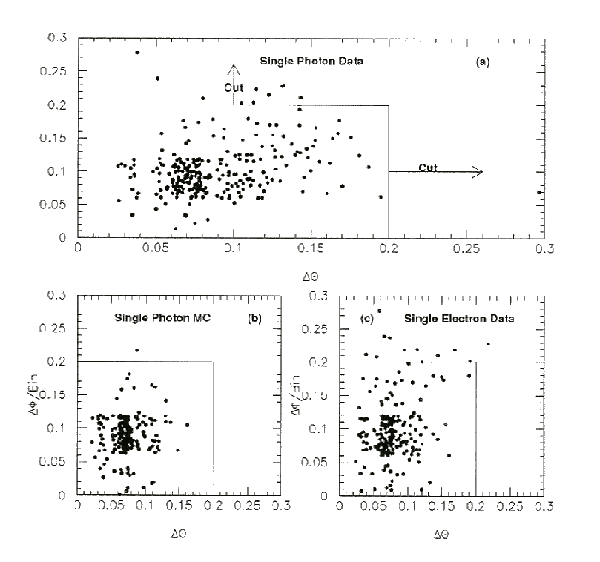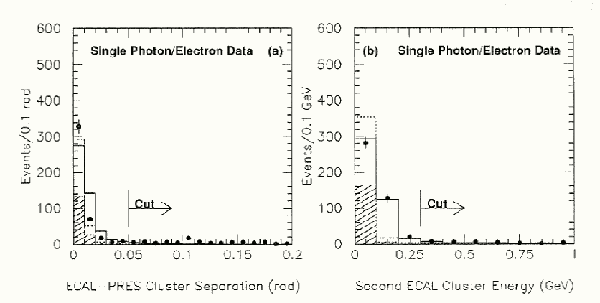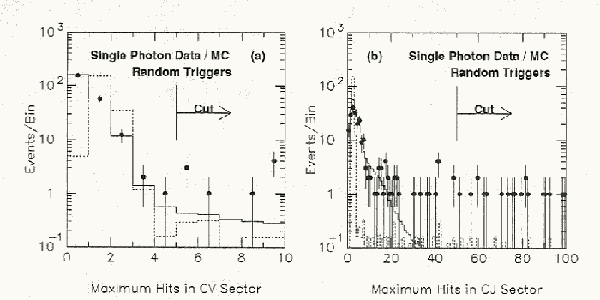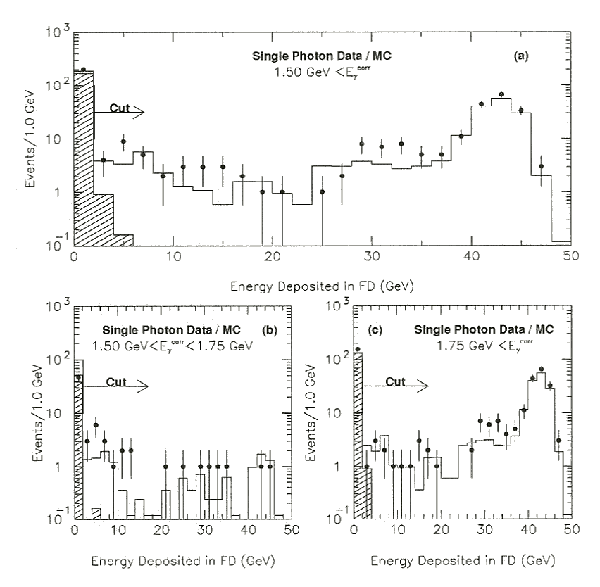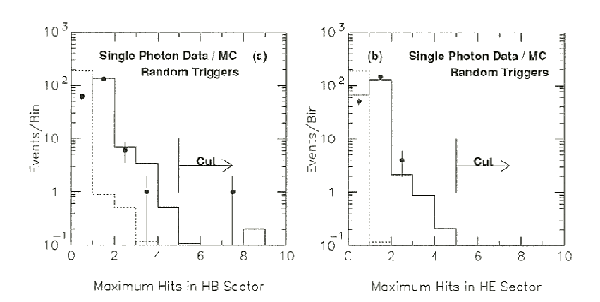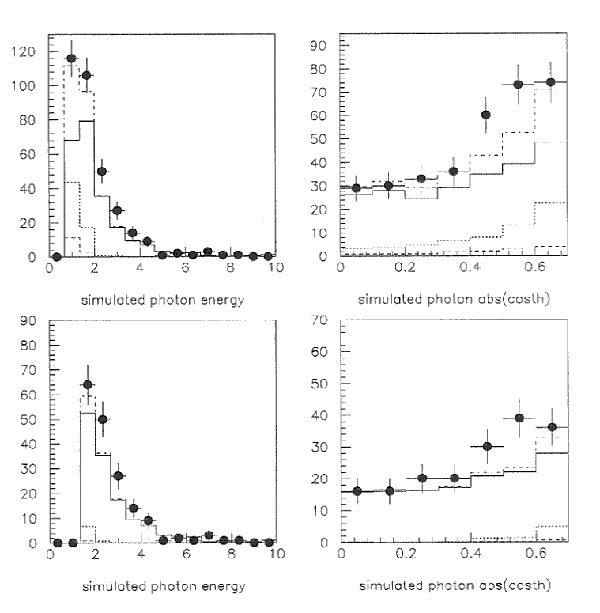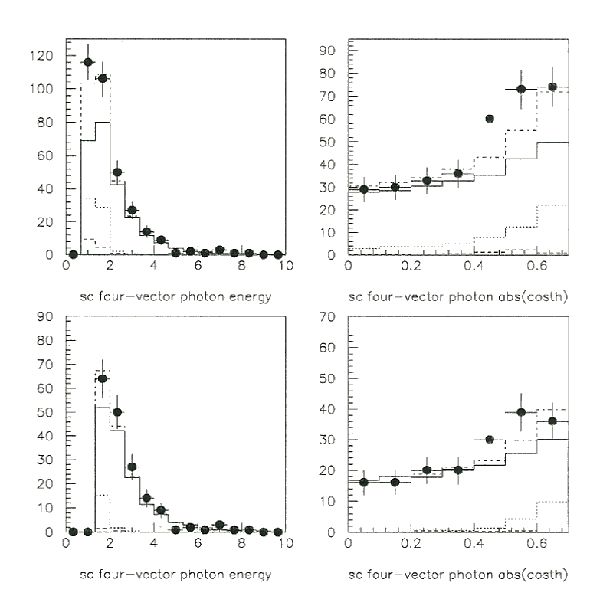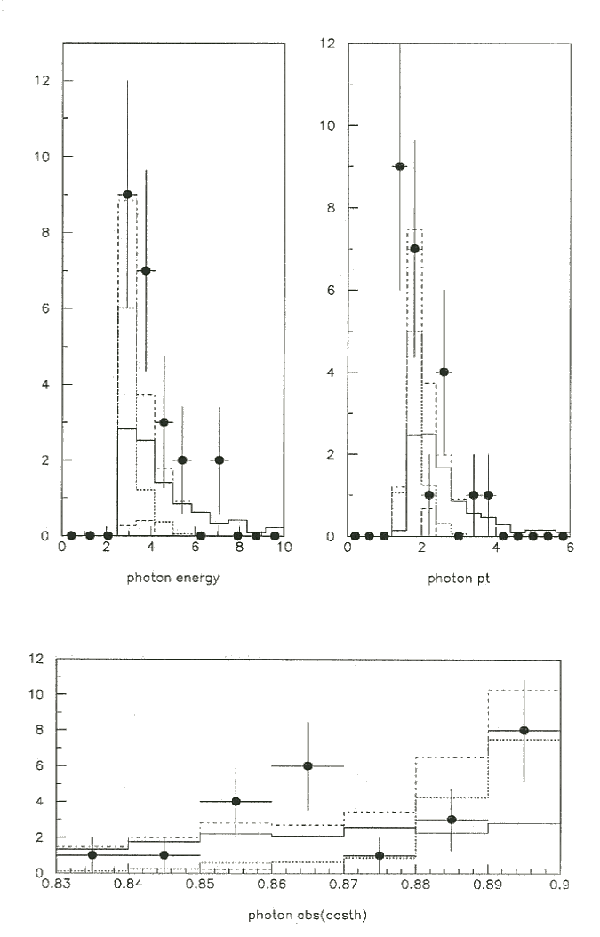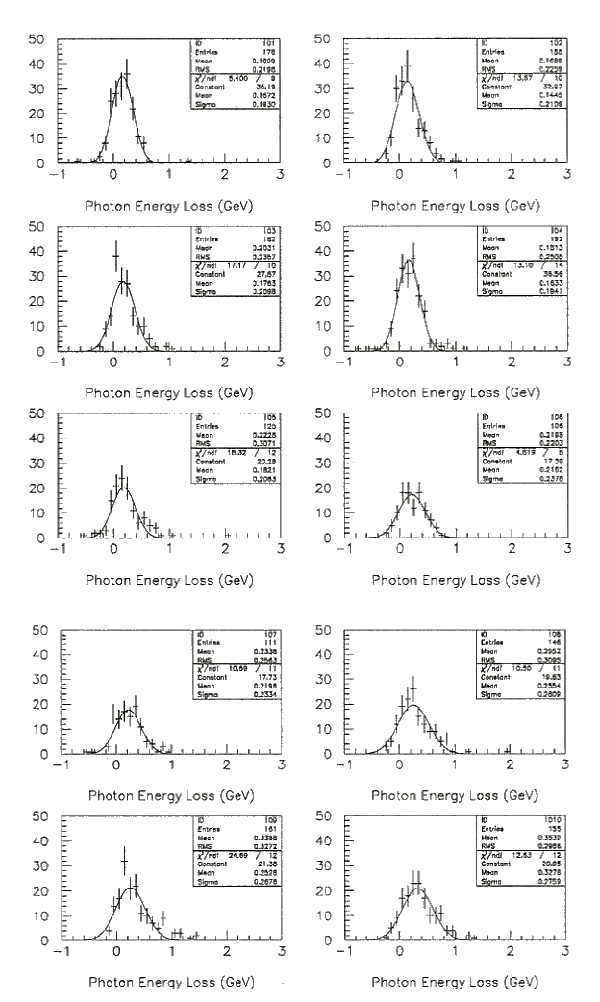


Chapter 6
The Single Photon Signal and Selection
The overall signature for a single photon event in the OPAL detector is a
single low energy photon, Eg » 1.5 GeV, observed in the
electromagnetic calorimeter with no other accompanying activity.
However, this signature can potentially be produced by many other types of
events, i.e. backgrounds to the e+e-® n[`(n)]g signal.
Since there are many other physics processes which can potentially produce a
similar signature, the single photon events must be selected so as to retain
the largest part of the e+e-® n[`(n)]g signal, while reducing as much as possible the
background events.
The selection criteria for the analysis presented below attempts to select the
maximum number of e+e-® n[`(n)]g events, while allowing the flexibility of selecting
other event types, like the tagged photon and single electron events.
The tagged photon events are used as a check of the forward detector simulation
and the systematics.
The single electron events are used to determine the trigger and event
selection efficiencies and to check the background veto capability and the
calorimeter response to electromagnetic showers.
The results of studies with the single electron events and the tagged photon
events are discussed where applicable in Chapters 8 and
Chapters 9.
This chapter discusses the single photon selection in the context of the entire
OPAL detector.
6.1 Single Photon Selection in the Barrel
The single photon events were selected from the ``data set'' corresponding to
periods 20 through 33, except 31 since it was a 90 kHz pretrigger test,
collected during the 1991 run of OPAL using the following selection criteria:
(1) Event Quality and Acceptance - To ensure the overall quality of
accepted event, the event must pass the detector trigger and status
requirements, the event filter, and the FYZ1 requirements.
To ensure clean acceptance of the single photon, the event must contain
an electromagnetic cluster with a corrected energy greater than 1.5 GeV within
the region |cosq| < 0.7.
Here, the corrected energy of an electromagnetic cluster is the total energy
observed in a 200 mrad half-angle cone centered on the highest energy cluster,
plus the energy scale correction.
(2) Cluster Size - The electromagnetic cluster must not extend
more than 200 mrad in the polar or azimuthal directions to further remove
grazing cosmic rays and beam halo muons in the electromagnetic barrel region.
(3) Second Cluster Veto - The event must not contain another
electromagnetic cluster with more than 300 MeV deposited energy more than
200 mrad away from the largest one in the barrel or endcap region.
This requirement removes spurious noise events and two photon events.
(4) Central Detector Veto - The event must not have a reconstructed
central detector track with 20 or more jet chamber hits and must not have a
vertex chamber sector with more than 5 hits or a jet chamber sector with more
than 50 hits.
The first part reduces charged events, while the second part removes beam
related backgrounds.
(5) Forward Detector Veto - The energy deposited in each forward
calorimeter must be less than 2 GeV to reduce the background from radiative
Bhabha scattering.
(6) Presampler Match - The event must have the highest multiplicity
presampler cluster within 50 mrad of the electromagnetic cluster.
This selects single photons which have initiated showering in the solenoidal
coil in front of the presampler and electromagnetic calorimeter, reducing
backgrounds from obliquely striking photons which do not traverse the
detector from the origin.
(7) Muon Chamber and HCAL Veto - The event must have fewer than 5
strips hit in any one of the barrel or endcap hadron calorimeter sectors and
fewer than 3 of the outer 8 layers of the hadron calorimeter with a strip hit.
The event must not have a reconstructed muon segment corresponding to 3 or more
layers with hits in any of the muon chambers.
This cut eliminates many of the remaining cosmic ray events.
6.1.1 Event Quality and Acceptance Criteria
The the event quality and acceptance criteria defines the overall global and
acceptance criteria for the single photon events.
Events are passed through the filter algorithm which selects and classifies
event types based on simple criteria for tracks and electromagnetic clusters.
The restrictions on the event types determined from the filter algorithm
are summarized in Table 4.7.
This analysis also requires the proper operation of certain important
sub-detectors for the selection of genuine single photon events.
A summary of the requirements for the trigger and detector status is shown
in Table 6.1.
Finally, the quality of the selected single photon energy cluster is ensured
by accepting photons which have a corrected energy, Egcorr, greater than
1.5 GeV in the barrel region (|cosq| < 0.7).
Here, the corrected energy of an electromagnetic cluster is the total energy
observed in a 200 mrad half-angle cone centered on the highest energy cluster
plus the energy scale correction (refer to Chapter 7).
| Element | CV | CJ | EB | EE | FD
| PB | TB | HS | |
| | Detector Status | 3 | 3 | 3 | 3 | 3 | 3(2) | - | 3 |
| Trigger Status | - | - | 3 | - | - | - | 3 | - |
|
Table 6.1: Detector and Trigger Status Requirements for the Data.
The detector and trigger status requirements for the sub-detectors
important to this analysis are required to be 3 with the exception of the
presampler barrel (refer to Chapter 8).
6.1.2 The Cluster Size Criterion
The cluster size criterion requires that the electromagnetic cluster not extend
more than 200 mrad in the polar or azimuthal directions.
This criterion is important for cutting beam halo events or cosmic rays which
obliquely traverse the barrel of the electromagnetic calorimeter often
depositing energy in a row of EB blocks.
Figure 6.1 shows single photon candidates compared to the e+e-® n[`(n)]g
Monte Carlo events and the single electron events.
The agreement between the plots indicates that a cut of 200 mrad on the
electromagnetic cluster size in the polar and the azimuthal angle ensures the
quality of the selected cluster, while rejecting characteristic beam halo or
oblique cosmic rays.
Figure 6.1: The Df and Dq for the Single Photon and Electron Candidates.
The polar and azimuthal angles for the single photon candidates are shown in (a).
The corresponding polar and azimuthal angles for the single photon Monte Carlo events are shown in (b). and for single electrons in (c).
The nominal cuts for Df and Dq are indicated by the arrows at Df < 0.2 rad and Dq < 0.2 rad.
6.1.3 The Second Cluster Veto Criterion
The second cluster veto criterion requires that the event not contain another
electromagnetic cluster with more than 300 MeV deposited energy more than
200 mrad away from the highest energy cluster.
This requirement removes events with a single photon within acceptance
accompanied by a second photon anywhere in the fiducial volume of the detector.
The Monte Carlo simulation for the signal process, e+e-® n[`(n)]g, includes the double
radiative process e+e-® n[`(n)]gg contributing an additional 3% of events with
this cut removed.
The additional 3% of events from e+e-® n[`(n)]gg are corrected for in comparing
the data to the e+e-® n[`(n)]g Monte Carlo signal.
The energy of the second ECAL cluster for the data and Monte Carlo is
seen to be in general agreement with the single electron sample for an energy
cut of Eg £ 300 MeV, as shown in Figure 6.2 (b).
Figure 6.2: The Spectra for the Presampler Calorimeter Criterion.
The effect of the cut on angular separation between the electromagnetic
(ECAL) and presampler (PRES) calorimeter showers is shown in (a), while the
cut on the energy of the second ECAL cluster is shown in (b).
The single photon candidates for the data are shown by solid dots with
statistical errors, while the single electron events are shown by the solid
histograms.
The single photon events for the Monte Carlo is shown by the plain-dotted
histograms for the e+e-® n[`(n)]g signal and by the hatched-dotted histograms for
the total single photon backgrounds consisting of e+e-® e+e-g, e+e-® gg(g), e+e-® m+m-g,
e+e-® t+t-g, and e+e-® e+e-X (X® f2,p0,h,h¢).
The nominal cut for the matching of the presampler and electromagnetic
calorimeter cluster is shown in (a) at qECAL-PRES < 0.2 rad,
while the nominal cut for the second electromagnetic cluster energy is shown
in (b) at E2nd < 0.3 GeV.
6.1.4 The Central Detector Veto Criterion
The central detector veto criterion removes events with a reconstructed central
detector track with more than 20 jet chamber hits or with a maximum number of
CV hits of 5 or CJ hits of 50 in any given sector.
Single photons which convert in the beam pipe or the central detector as well
as beam-wall or beam-gas events are removed from the selected events.
The photon conversion probability in these regions is taken from the single
photon Monte Carlo to be 6.86±0.53.
Comparison of the conversion probability for data and Monte Carlo from photon
pairs and lepton pairs indicates good agreement with this result as shown in
Table 8.1.
With these cuts removed, the single photon candidates are shown in
Figure 6.3 compared to random beam crossings normalized to
the number of single photon candidates.
The level of activity in CV and CJ for the single photon candidates is seen to
agree with expectations from the noise in the detectors as predicted by the
random beam crossings.
The data points are also compared to the total Monte Carlo expectations from
the signal and backgrounds combined.
The agreement here is reasonable but less exact, reflecting slightly less than
ideal simulation of noise in the central detector.
Figure 6.3: The Single Photon Candidates and Random Events in CV and CJ.
The maximum number of CV hits (a) and the maximum number of CJ hits (b)
for single photon candidates are shown by solid dots with statistical errors.
The total Monte Carlo is shown by the dotted histogram, and the corresponding
random trigger events are shown by the solid histogram.
With the cuts on the maximum number of CV and CJ hits removed, the agreement
between the data, the Monte Carlo, and the random beam crossings indicates
that the CV and CJ occupancy is consistent with random noise from the
detector.
The nominal cut for the maximum number of hits in a CV sector is shown in (a)
at CVmax. hits < 5 hits.
The nominal cut for the maximum number of hits in a CJ sector is shown in (b)
at CJmax. hits < 50 hits.
6.1.5 The Forward Detector Veto Criterion
The forward detector veto criterion removes events with more than 2 GeV of
activity in either forward calorimeter.
This cut removes much of the background to the e+e-® n[`(n)]g signal at low angles,
especially for the low Q2 Bhabha events.
Figure 6.4 shows the level of agreement between the single
photon candidates and the Monte Carlo for the backgrounds and the e+e-® n[`(n)]g signal
at low Egcorr.
The level of agreement between the single photon candidates and the Monte
Carlo e+e-® n[`(n)]g signal and backgrounds indicates that the forward detector
background rejection is well understood and fully efficient for
Egcorr ³ 1.5 GeV.
Figure 6.4: The Single Photon Candidates and Total Backgrounds for the FD.
To study the vetoing capability of the forward detector, the energy
spectra of the single photon candidates is compared to the Monte Carlo for
the e+e-® n[`(n)]g signal and the backgrounds.
The single photon candidates for both the first and the second data sample
together are shown in (a) with the forward detector cut removed.
The single photon events with 1.5 GeV < Egcorr < 1.75 GeVare shown in (b),
while events with Egcorr ³ 1.75 GeVare shown in (c) with the forward
detector cut removed.
The data are shown by solid dots with statistical errors, while the solid
histogram shows the Monte Carlo from the total backgrounds consisting
of e+e-® e+e-g, e+e-® gg(g), e+e-® m+m-g, e+e-® t+t-g, and e+e-® e+e-X (X® f2,p0,h,h¢).
The hatched histogram shows the Monte Carlo from the signal events from the
process e+e-® n[`(n)]g.
The nominal cut for the forward detector is shown at
SEFD right, SEFD left < 2.0 GeV.
6.1.6 The Presampler Match Criterion
The presampler match criterion requires that the event have a presampler
cluster within 50 mrad of the electromagnetic cluster of the single photon
candidate.
This criterion removes background from cosmic ray and beam halo events.
The presampler matching is taken from the single photon Monte Carlo to be
96.40±0.46.
Comparison of the presampler matching for data and Monte Carlo from photon
pairs and lepton pairs indicates agreement to within 2% as shown in
Table 8.1.
In Figure 6.2 (a), the single photon candidates for the data
and Monte Carlo are shown along with the single electron sample.
The single photon candidates are seen to be consistent with the expectations
from the single electron sample for matching half-angles of up to 50 mrad.
6.1.7 The Muon Chamber and HCAL Veto Criteria
The muon chamber and HCAL veto criteria removes events with activity in the
muon chambers or events with more than 5 strip hits in any of the hadron
calorimeter barrel (HB) or endcap (HE) sectors.
This selection criteria removes cosmic ray and muon events.
With these cuts removed, the single photon candidates are shown in
Figure 6.5 compared to random beam crossings normalized to
the number of single photon candidates.
The level of agreement between the two indicates that the distributions in the
data are consistent with the noise of the detectors revealed by the random
beam crossings.
The data points are also compared to the total Monte Carlo expectations from
the signal and backgrounds combined.
Here the agreement is reasonable but less exact, perhaps indicating a slight
discrepancy in the simulation of the noise for the hadron calorimeter.
Figure 6.5: The Single Photon Candidates and Random Beam Crossing Events
in HB and HE.
The maximum number of HB hits (a) and the maximum number of HE hits (b)
for single photon candidates are shown by solid dots with statistical errors,
the total Monte Carlo is shown by the dotted histogram, and the corresponding
random trigger events are shown by the solid histogram.
When the cuts on the maximum number of HB and HE are removed, the agreement
between the data, the Monte Carlo, and the random beam crossings indicates
that the HB and HE occupancy is consistent with random noise from the
detectors.
The nominal cut for the maximum number of hits in an HB sector is shown in (a)
at HBmax. hits < 5 hits.
The nominal cut for the maximum number of hits in a HE sector is shown in (b)
at HEmax. hits < 5 hits.
6.1.8 The Single Photon Events in the Barrel
Using the above selection criteria the total integrated luminosity of the
sample of 1991 data set analyzed amounts to 13.076±0.089 pb-1.
From this sample of data, 201 events with Egcorr ³ 1.75 GeV are selected
in the electromagnetic barrel region (EB) of the OPAL detector.
Table 6.2 shows the number of events selected with the
inclusion of each selection criterion for the data and Monte Carlo, e+e-® n[`(n)]g and
the total backgrounds.
Table 6.3 shows the exclusive number of events cut with each
selection criterion for the data as well as the Monte Carlo, e+e-® n[`(n)]g and the total
backgrounds.
| CUT | CRITERIA | EVENTS REMAINING |
| | Data | MC | Bckgrnd MC |
| | 16885 | 11550 | 9572 | |
| | 1 | Event Quality | 12734 | 4450 | 6071 |
| and Acceptance | 8081 | 1633 | 2148 |
| 2 | Cluster Size | 4888 | 1633 | 2148 |
| 3 | 2nd Cluster Veto | 4380 | 1571 | 1767 |
| 4 | Central Detector Veto | 4109 | 1529 | 1717 |
| 5 | Forward Detector Veto | 3747 | 1521 | 120 |
| 6 | Presampler Match | 213 | 1162 | 106 |
| 7 | Muon/HCAL Veto | 201 | 1125 | 106 | |
| | TOTAL | ALL CRITERIA | 201 | 1125
| 135 |
|
Table 6.2: Inclusive Number of Events Selected by the Selection Criteria.
The inclusive number of events selected by the application of the
selection criteria is shown for the preselected data, the e+e-® n[`(n)]g Monte Carlo
events, and the background Monte Carlo events including e+e-® e+e-g, e+e-® gg(g), e+e-® m+m-g,
e+e-® t+t-g, and e+e-® e+e-X (X® f2,p0,h,h¢).
The Monte Carlo events represent more than five times the luminosity of the
data.
| CUT | CRITERION | EVENTS CUT |
| | Data | MC | Bckgrnd MC |
| | 16885 | 11550 | 9572 | |
| | 1 | Event Quality | 4131 | 7100 | 3501 |
| and Acceptance | 6623 | 9826 | 7351 |
| 2 | Cluster Size | 7671 | 1940 | 3107 |
| 3 | 2nd Cluster Veto | 7127 | 219 | 1490 |
| 4 | Central Detector Veto | 2621 | 1137 | 1518 |
| 5 | Forward Detector Veto | 2309 | 33 | 4489 |
| 6 | Presampler Match | 13868 | 3338 | 3008 |
| 7 | Muon/HCAL Veto | 943 | 736 | 340 |
|
Table 6.3: Exclusive Number of Events Cut by the Selection Criteria.
The exclusive number of events cut by each selection criterion is shown
for the preselected data, the e+e-® n[`(n)]g Monte Carlo events, and the background Monte
Carlo events including e+e-® e+e-g, e+e-® gg(g), e+e-® m+m-g, e+e-® t+t-g, and e+e-® e+e-X (X® f2,p0,h,h¢).
The Monte Carlo events represent more than five times the luminosity of the
data.
For the purposes of studying the effect of the energy cut on the backgrounds
and the efficiencies, the single photons selected are divided into two samples.
The first sample consists of 46 events with 1.5 GeV < Egcorr < 1.75 GeV,
while the second sample consists of 155 events with Egcorr ³ 1.75 GeV.
Table 6.4 shows the luminosity and the number of single photon
events at each center-of-mass energy point for the two different samples.
| Ös | L | NUMBER OF EVENTS |
| (GeV) | (pb-1)
| 1.5 GeV < Egcorr < 1.75 GeV
| Egcorr > 1.75 GeV | |
| | 88.45 | 0.826±0.004 | 1 | 2 |
| 89.45 | 0.798±0.004 | 2 | 5 |
| 90.20 | 0.870±0.004 | 3 | 10 |
| 91.20 | 8.049±0.013 | 27 | 71 |
| 91.95 | 0.825±0.004 | 6 | 14 |
| 92.95 | 0.794±0.004 | 3 | 23 |
| 93.70 | 0.913±0.004 | 4 | 30 | |
| | Total | 13.076±0.016 | 46 | 155 |
|
Table 6.4: Selected Single Photon Events from the 1991 Data Set.
The overall integrated luminosity for the 1991 data set used.
The number of events accepted in the barrel region for the single photon
analysis is shown for both the first sample (1.5 GeV < Egcorr < 1.75 GeV) and
the second sample (Egcorr ³ 1.75 GeV).
Notice the large increase in the number of accepted events for a given
luminosity at the higher center-of-mass energy points.
6.2 Single Photon Selection in the Endcap
The report of increased performance of the electromagnetic calorimeter in the
1991 run [88] raised hopes that the endcap electromagnetic
calorimeter (EE) would contribute to a single photon measurement.
Although the electromagnetic endcap calorimeter (EE) has acceptable energy
loss and resolution, the real deciding factor for purposes of single photon
counting is the contribution from the known principal background, e+e-® e+e-g, and
the potentially large contribution from e+e-® e+e-X (X® f2,p0,h,h¢) and other backgrounds.
The signal and background from the endcap region is quantified by the following
ratio
With respect to the e+e-® n[`(n)]g signal in the barrel region, the e+e-® n[`(n)]g signal in the
endcap region is also comparable with the ratio
Having defined these ratios, the following key issues must be addressed before
including the endcap single photon signal with that of the barrel for a
measurement of the number of single photon events:
(1) Is the background to signal ratio in the endcap region comparable
to that in the barrel region?
(2) Is the gain in the actual number of e+e-® n[`(n)]g events from the endcap
region enough to compete statistically and systematically with the barrel
region?
6.2.1 Study of the Endcap Single Photon Acceptance
Single photon events have been selected from the 1991 data set for the barrel
and the endcap electromagnetic calorimeter slightly differently from the
selection given in Section 6.1.
The main differences between the single photon acceptance in the barrel region
described in Section 6.1 and the single photon acceptance in
the barrel and endcap region described here for the study of the endcap single
photon acceptance involves the following differences:
(1a) Event Quality - The event must pass the detector
trigger and status requirements shown in Table 6.5.
The differences in the requirements is motivated by the necessity to ensure
triggering on the endcap to select quality events.
(1b) Acceptance - The acceptance cut on the single photon energy is on
the raw energy, Eg, rather than the corrected energy, Egcorr.
The event must contain an electromagnetic cluster with a raw energy, Eg,
greater than 1.0 GeV in the region |cosq| < 0.7 (barrel) and
greater than 2.75 GeV in the range 0.83 < |cosq| < 0.95 (endcap).
Since the endcap electromagnetic energy triggers events with Eg > 3.0
GeV, the acceptance in energy is low enough to allow the largest possible
selection of single photon events while ensuring quality of the selected
events within the threshold of triggering.
(6) Presampler Match - The event must have the highest multiplicity
presampler cluster within 200 mrad of the electromagnetic cluster.
| Element | CV | CJ | EB | EE | FD
| PB | TB | HS | |
| | Detector Status | 3 | 3 | 3 | 3 | 3 | 3(2) | - | 3 |
| Trigger Status | 3 | 3 | 3 | 3 | - | - | 3 | - |
|
Table 6.5: Detector and Trigger Status Requirements for the Data.
The detector and trigger status requirements for the sub-detectors
important to this analysis are required to be 3 with the exception of the
presampler barrel.
It is not surprising that the selection criteria for the barrel and the endcap
regions are quite similar.
This is because the e+e-® n[`(n)]g signal is essentially the same in both regions,
aside from the fact that there is no time-of-flight (TOF) coverage in the
endcap region.
In the barrel region, the single photon events are triggered by both the TOF
trigger (TPTOEM) and the electromagnetic calorimeter (EBTPHI), while in the
the endcap regions, the single photon events are triggered only by the
electromagnetic calorimeter (EELTPH.OR.EERTPH).
Since the EELTPH and EERTPH triggers have a threshold of approximately 3.0 GeV,
it is sensible to choose a cut for Eg near this value to ensure
quality of selected events and at the same time retain as many events in the
endcap region as possible.
The value of Eg > 2.75 GeV has been chosen since this corresponds
to a 75% efficiency for triggering on single photons in the endcap region.
The choice of the angular acceptance in the endcap region is primarily dictated
by the requirement that only photons which pre-shower be accepted, hence
0.83 < |cos(qg)| < 0.95.
Since the endcap does not have the redundancy from the TOF coverage in the
case that presampler does not shower, the matching of the highest energy
presampler cluster match is extended to 200 mrad.
Using the above criteria the total integrated luminosity of the 1991 data
set analyzed amounts to 12.613±0.015 pb-1.
Table 6.6 shows the luminosity, the fraction of single photon
events and the number of single photon events at each center of mass energy.
From the data, 335 events with Eg > 1.0 GeV and 177 events with
Eg > 1.5 GeV have been selected in the barrel region and
41 events with Eg > 2.75 GeV have been selected in the endcap region
as shown in Table 6.6.
Figure 6.6, shows the energy and angular photon spectra for
the barrel region, while Figure 6.7 shows the same for the
endcap region with specific optimized cuts (to be discussed in
Section 6.2.2).
It is worth noting that the additional gain of 41 events from the endcap region
would represent an increase of 23.2% in single photon signal with respect to
the barrel region.
Before drawing a conclusion about the usefulness of these additional events,
a complete understanding of the backgrounds to the endcap events for making a
single photon measurement is required.
| Ecm | L | F(EB) (N(EB))
| F(EB) (N(EB)) | F(EE) (N(EE)) |
| (GeV) | (pb-1)
| Eg > 1.0 GeV
| Eg > 1.5 GeV
| Eg > 2.75 GeV | |
| | 88.45 | 0.811±0.004 | 2.39 (8 Evnts.) | 1.13 (2 Evnts.)
| 9.76 (4 Evnts.) |
| 89.45 | 0.771±0.004 | 2.99 (10 Evnts.) | 3.39 (6 Evnts.)
| 9.76 (4 Evnts.) |
| 90.20 | 0.854±0.004 | 6.27 (21 Evnts.) | 6.21 (11 Evnts.)
| 7.32 (3 Evnts.) |
| 91.20 | 7.689±0.012 | 53.4 (179 Evnts.) | 49.7 (88 Evnts.)
| 46.3 (19 Evnts.) |
| 91.95 | 0.811±0.004 | 9.25 (31 Evnts.) | 9.04 (16 Evnts.)
| 9.76 (4 Evnts.) |
| 92.95 | 0.780±0.004 | 9.85 (33 Evnts.) | 11.9 (21 Evnts.)
| 7.32 (3 Evnts.) |
| 93.70 | 0.897±0.004 | 15.8 (53 Evnts.) | 18.6 (33 Evnts.)
| 9.76 (4 Evnts.) |
|
Table 6.6: Fraction and Number of Special Single Photon Candidates from the 1991
Data Set.
The overall integrated luminosity for the 1991 data set used in the study
of the endcap calorimeter.
The fraction and number of events accepted in the barrel region is shown for
two energy cuts, Eg > 1.0 GeV and Eg > 1.5 GeV, as well as in the
endcap for the energy cut, Eg > 2.75 GeV.
Figure 6.6: Comparison of Fully Simulated Monte Carlo and Data in EB.
The observed simulated photon energy (a) and simulated photon angular
spectrum (b) are shown for the single photons in EB with Eg > 1.0 GeV.
Similar spectra are shown in (c) and (d) for single photons in EB with
Eg > 1.5 GeV.
The fully simulated total Monte Carlo is shown by the non-uniform dashed line,
the e+e-® n[`(n)]g process by the solid line, the e+e-® e+e-g process by the small dashed line,
and the e+e-® e+e-X(X® f2,p0,h,h¢) process by the large dashed line.
Figure 6.7: Comparison of the Simulation Corrected Four-vectors and Data in EB.
The observed simulated photon energy (a) and simulated photon angular
spectrum (b) are shown for the single photons in EB with Eg > 1.0 GeV.
Similar spectra are shown in (c) and (d) for single photons in EB with
Eg > 1.5 GeV.
The total simulation corrected four-vectors Monte Carlo is shown by the
non-uniform dashed line, the e+e-® n[`(n)]g process by the solid line, the e+e-® e+e-g process
by the small dashed line, and the e+e-® e+e-X(X® f2,p0,h,h¢) process by the large dashed
line.
6.2.2 The Results of the Simulation Corrected Four-Vectors Study in the Endcap
The method of simulation corrected (SC) four-vectors [67] has
been used in the endcap to compare the data to high statistics Monte Carlo
samples in order to save CPU processing time (up to a factor 1,000 in time
saved).
Tests of the method indicate that the results of the SC four-vectors reproduce
the equivalent fully simulated results to within 15% for this analysis.
Single photon selection cuts have been optimized with the high statistics SC
four-vectors in the endcap region resulting in two sets of optimized cuts:
(1) The photon is selected if it passes the criteria in
Subsection 6.1 and falls in the angular acceptance cut
0.83 < |cos(qg)| < 0.90.
(2) The photon is selected if it passes the criterion of
Subsection 6.2 and has pt > 1.785 GeV.
Using the first cut, 0.83 < |cos(qg)| < 0.90, a total of 24 events have been
selected from the data, while the total Monte Carlo prediction is 29.22 events.
A comparison of the data and Monte Carlo for the photon energy, the photon
transverse momentum, and the angular spectrum are shown in (a), (b), and (c)
of Figure 6.8.
The expected Monte Carlo ratio of background to signal is
|
|
| | |
|
s (e+e-g+ e+e-X) in EE
|
= 90% |
|
|
|
|
which is equivalent to 12.35 additional e+e-® n[`(n)]g events from the total of the 24
events observed in the endcap with this set of cuts.
There is certainly reasonable agreement between the data and the SC
four-vectors of the Monte Carlo, especially considering the low statistics.
The ratio of the additional 12.35 e+e-® n[`(n)]g events in the endcap region to the
e+e-® n[`(n)]g signal in the barrel region is
Figure 6.8: The Photon Spectra with the Optimized Angular Cut in EE.
The photon energy is shown in (a), while the transverse momentum spectra
is shown in (b).
The total SC four-vectors Monte Carlo is shown by the non-uniform dashed line,
the e+e-® n[`(n)]g process by the solid line, the e+e-® e+e-g process by the small dashed line,
and the e+e-® e+e-X(X® f2,p0,h,h¢) process by the large dashed line.
Using the second cut, pt > 1.785 GeV, a total of 16 events have been
selected from the data, while the total Monte Carlo prediction is 13.23 events.
A comparison of the data and Monte Carlo for the photon energy, the photon
transverse momentum, and the angular spectrum are shown in (a), (b), and (c)
of Figure 6.9.
The expected Monte Carlo ratio of background to signal is
|
|
| | |
|
s (e+e-g+ e+e-X) in EE
|
= 32% |
|
|
|
|
which is equivalent to 12.12 additional e+e-® n[`(n)]g events from the total of 16
events observed in the endcap with this set of cuts.
Again, within statistics, there seems to be reasonable agreement between the
data and the SC four-vectors of the Monte Carlo.
The ratio of the additional 12.12 e+e-® n[`(n)]g events in the endcap region to the
e+e-® n[`(n)]g signal in the barrel region is
Finally, from the two sets of optimized cuts, good agreement between the data
and SC four-vectors is observed.
While the optimized angular cut yields the largest contribution of additional
e+e-® n[`(n)]g events to the single photon signal in the barrel, the pt cut yields
the best over all signal to background ratio.
]
Figure 6.9: The Photon Spectra with Optimized pt Cut in EE.
The photon energy is shown in (a), while the transverse momentum spectra
is shown in (b).
The total SC four-vectors Monte Carlo is shown by the non-uniform dashed line,
the e+e-® n[`(n)]g process by the solid line, the e+e-® e+e-g process by the small dashed line,
and the e+e-® e+e-X(X® f2,p0,h,h¢) process by the large dashed line.
Unfortunately, neither the 12.12 additional single photon events obtained
from the optimized pt cut nor the additional 12.35 single photon events
obtained from the optimized angular cut when accompanied by the rather large
background to signal ratio are considered suitable to be included in the single
photon measurement from the 1991 data set presented in this thesis.



